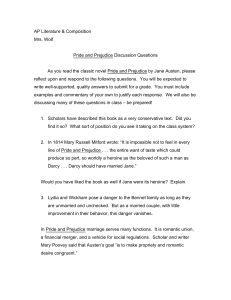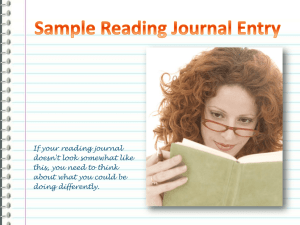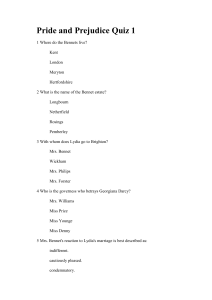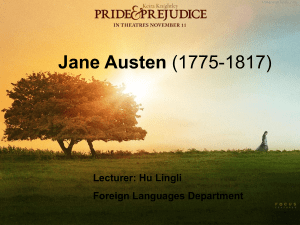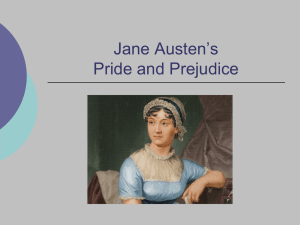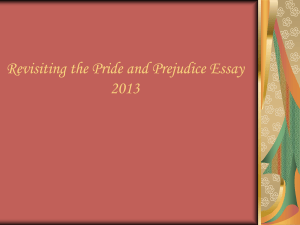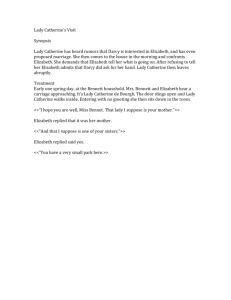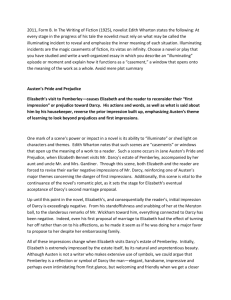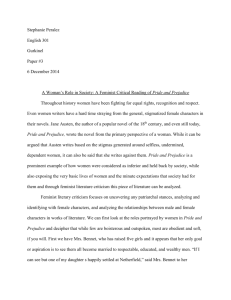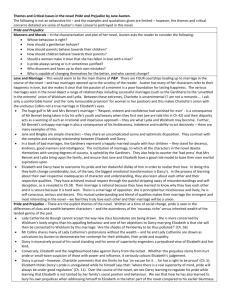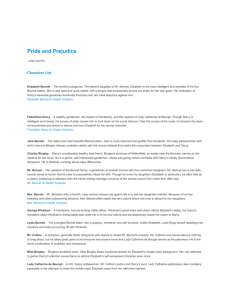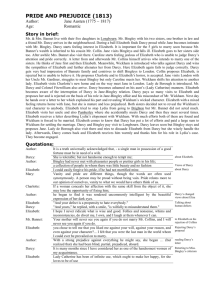Pride and Prejudice chapter Q`s
advertisement
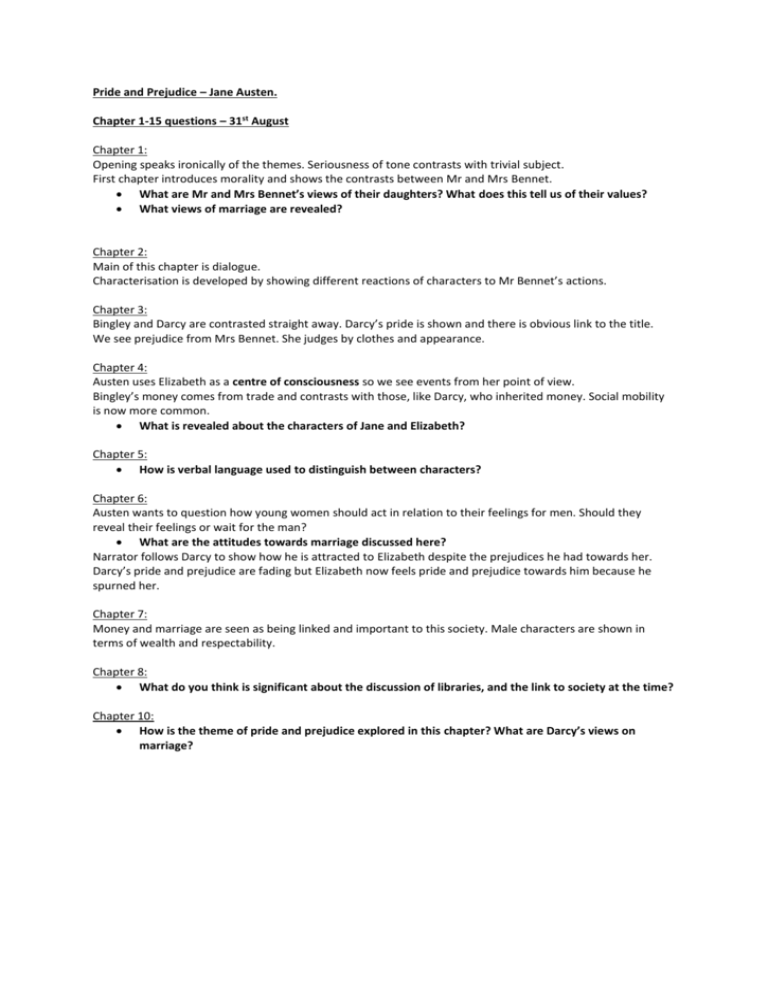
Pride and Prejudice – Jane Austen. Chapter 1-15 questions – 31st August Chapter 1: Opening speaks ironically of the themes. Seriousness of tone contrasts with trivial subject. First chapter introduces morality and shows the contrasts between Mr and Mrs Bennet. What are Mr and Mrs Bennet’s views of their daughters? What does this tell us of their values? What views of marriage are revealed? Chapter 2: Main of this chapter is dialogue. Characterisation is developed by showing different reactions of characters to Mr Bennet’s actions. Chapter 3: Bingley and Darcy are contrasted straight away. Darcy’s pride is shown and there is obvious link to the title. We see prejudice from Mrs Bennet. She judges by clothes and appearance. Chapter 4: Austen uses Elizabeth as a centre of consciousness so we see events from her point of view. Bingley’s money comes from trade and contrasts with those, like Darcy, who inherited money. Social mobility is now more common. What is revealed about the characters of Jane and Elizabeth? Chapter 5: How is verbal language used to distinguish between characters? Chapter 6: Austen wants to question how young women should act in relation to their feelings for men. Should they reveal their feelings or wait for the man? What are the attitudes towards marriage discussed here? Narrator follows Darcy to show how he is attracted to Elizabeth despite the prejudices he had towards her. Darcy’s pride and prejudice are fading but Elizabeth now feels pride and prejudice towards him because he spurned her. Chapter 7: Money and marriage are seen as being linked and important to this society. Male characters are shown in terms of wealth and respectability. Chapter 8: What do you think is significant about the discussion of libraries, and the link to society at the time? Chapter 10: How is the theme of pride and prejudice explored in this chapter? What are Darcy’s views on marriage? Chapter 12: No dialogue but omniscient narration. Narrator is judgmental of Mary’s character. Chapter 13: The Bennet’s home is in a legal arrangement so that it can only be inherited by a male. This hangs over the Bennet daughters. This system is criticised even by characters such as Lady Catherine. Reactions to Mr Collins’ letter show contrasts between the Bennets. Discuss what Mr Collins’ letter reveals about his character? Chapter 15: How is Mr Collins’ further developed in this chapter? Chapter 16 – 30. September 7th. Chapter 16: Consists of a conversation between Elizabeth and Wickham which focuses on Darcy’s pride. How is the theme of prejudice developed in this episode? Think about the unreliability of appearance. Chapter 19: Discuss the use of speech and language in this chapter and what it reveals of characterisation. Chapter 21: In reading the letter, Jane and Elizabeth provide differences in view and outlook. Chapter 22: The description of Collins’ marriage proposal is ironic and very negative. What are Charlotte’s views on marriage? Chapter 24: Differences between Jane and Elizabeth are again contrasted. Elizabeth believes in love being at the centre of marriage, whereas the novel seems to show it as being based on money. Chapter 26: Use of free indirect speech to show Elizabeth’s thought patterns. Chapter 27: Important discussion of role of money in marriage. Chapter 30 – 45. 21st September. Chapter 31: Darcy’s pride is disappearing; he doesn’t mind being the butt of Elizabeth’s jokes. Their relationship depends on pride and prejudice being turned around. Lady Catherine personifies pride and prejudice in a caricature-like way. Chapter 32: How does Darcy continue to show prejudice? Chapter 33: Irony of Elizabeth misreading Darcy’s behaviour Chapter 34: Darcy struggles to find eloquent words for his feelings, he has a strong sense of his superiority in society and assumes Elizabeth will accept his proposal. However, Elizabeth realises she was too quick to believe Wickham and is angry at herself for rejecting the proposal. Chapter 35: How does Elizabeth misjudge Darcy? What point do Darcy and Mr Bennet make about the future of the older Bennet girls? Discuss why letters are used so often in the novel? Chapter 36: This chapter marks a turning point in the opinions of Elizabeth. Elizabeth has to reassess her attitude towards Darcy and Wickham and we are also forced to shift with her. Chapter 39: What does Lydia’s speech tell us and how does that link to Darcy’s initial concerns? Chapter 40: Important discussion of a theme – appearance vs reality as shown in Darcy and Wickham. “One has all the goodness, and the other all the appearance of it”. Chapter 41: The narrator shows us Lydia’s imagination and shows that her image of Brighton is all about appearance. We are also reminded of theme through the discussion of appearance again. Chapter 43: Elizabeth’s feelings towards Darcy start to change. Pemberley makes her rethink what kind of person Darcy is and breaks down her prejudice. What might be significant in the description of Pemberley? Chapter 44: An unprejudiced view of Georgiana shows she is shy, not proud, and makes us rethink Darcy’s character. Chapter 45: Irony that Caroline Bingley’s jealousy backfires and has the opposite effect, much like Lady Catherine’s interference later in the novel. Chapter 46: One of the most melodramatic scenes. What does the discussion concerning Lydia’s disappearance tell us about social values at that time? Irony that as Elizabeth realises she loves Darcy, she believes that Lydia’s actions mean he will not want her and it is over forever. Chapter 48: Mr Bennet accepts responsibility for Lydia’s actions but seems disengaged from the reality of what has happened. How is he portrayed as a father and husband? Chapter 49: Clothes are used as a recurring motif to show female triviality and the obsession is shared by Lydia and Mrs Bennet. Chapter 50: Money is discussed. Mr Bennet is shown as being irresponsible by not being able to provide for his daughters and Mrs Bennet is unable to see the financial implications of Lydia’s actions. Chapter 52: Discuss what Elizabeth’s use of language here is Chapter 53: How is Mrs Bennet portrayed in this chapter? Chapter 54: There is comedy as Jane and Elizabeth try to hide their true feelings from each other but the reader knows the truth. Chapter 55: Explain what point is made about the opinion of society here. Chapter 56: Carriages are used to show status of characters through size and luxury of characters. Explain how Austen presents pride and prejudice in this chapter. Chapter 57: Examine how Mr Bennet is portrayed negatively in this chapter Chapter 58: In this chapter Elizabeth and Darcy express their feelings towards each other. In order to move on together, they both need to swallow their pride and admit that they were wrong. Elizabeth was wrong in terms of judging Darcy, believing Wickham and the lies about Darcy. Darcy admits that he had not behaved well and that Elizabeth had made him change his ways. Chapter 59: Due to Elizabeth hiding her feelings, no-one believes she loves Darcy. Mrs Bennet only needs to know that he is wealthy to be happy for her daughter, and now sees Darcy as handsome and not “disagreeable”. Chapter 60: Darcy and Bingley cannot stand the inlaws and try to avoid having contact. Their good manners mean they are polite but Austen does not show them all living together happily; Darcy still does not like Mrs Bennet. Chapter 61: How does Austen avoid being too sentimental in the last chapter?
